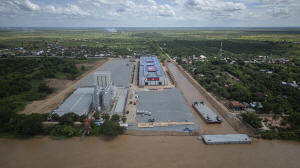Cambodia hopes a new canal will boost trade. But it risks harming the
Mekong that feeds millions.
 Send a link to a friend
Send a link to a friend
 [September 25, 2024] By
ANIRUDDHA GHOSAL [September 25, 2024] By
ANIRUDDHA GHOSAL
PREK TAKEO, Cambodia (AP) — The Mekong River is a lifeline for millions
in the six countries it traverses on its way from its headwaters to the
sea, sustaining the world’s largest inland fishery and abundant rice
paddies on Vietnam's Mekong Delta.
Cambodia's plan to build a massive canal linking the Mekong to a port on
on its own coast on the Gulf of Thailand is raising alarm that the
project could devastate the river's natural flood systems, worsening
droughts and depriving farmers on the delta of the nutrient-rich silt
that has made Vietnam the world's third-largest rice exporter.
Cambodia hopes that the $1.7 billion Funan Techo canal, being built with
Chinese help, will support its ambition to export directly from
factories along the Mekong without relying on Vietnam, connecting the
capital Phnom Penh with Kep province on Cambodia's southern coast.
At an Aug. 5 groundbreaking ceremony, Cambodian Prime Minister Hun Manet
said the canal will be built “no matter what the cost.” By reducing
costs of shipping to Cambodia's only deep-sea port, at Sihanoukville,
the canal will promote, “national prestige, the territorial integrity
and the development of Cambodia,” he said.
Along with those promises comes peril. Here is a closer look.

The threat to the Mekong
The Mekong River flows from China through Myanmar, Thailand, Laos,
Cambodia and Vietnam. It supports a fishery that accounts for 15% of the
global inland catch, worth over $11 billion annually, according to the
nonprofit World Wildlife Fund. Flooding during the wet season makes the
Mekong Delta one of the world's most productive farm regions.
The river already has been disrupted by dams built upstream in Laos and
China that restrict the amount of water flowing downstream, while rising
seas are gnawing away at the southern edges of the climate-vulnerable
Mekong Delta.
Brian Eyler, director of the Washington-based Stimson Center’s Southeast
Asia Program, warns that high embankments along the 100-meter (328
feet)-wide, 5.4-meter (17.7 feet)-deep canal will prevent silt-laden
floodwater from flowing downstream to Vietnam. That could worsen drought
in Vietnam's rice bowl and Cambodia's floodplains, an area stretching
over roughly 1,300-square kilometers (501 square miles).
The view from Vietnam's rice bowl
A drier Mekong Delta is a concern for Vietnam’s agricultural sector,
which powers 12% of its economy. The southwestern provinces of An Giang
and Kien Giang would likely be most impacted. The delta's latticework of
rivers crisscrossing green fields is vital for Vietnam’s own plans of
growing “high quality, low emission rice” on 1 million hectares of
farmland by 2030. The aim is to cut earth-warming greenhouse gases,
lower production costs and increase farmers’ profits.
Water from the river is “essential” not just for Vietnam's more than 100
million people but also for global food security, said Nguyen Van Nhut,
director of rice export company Hoang Minh Nhat.
Vietnam’s exports of 8.3 million metric tons (9.1 U.S. tons) of rice in
2023 accounted for 15% of global exports. Most was grown in the Mekong
Delta. The amount of silt being deposited by the river has already
dropped and further disruptions will worsen salinity in the area,
hurting farming, Nhat said.
“This will be a major concern for the agriculture sector of the Mekong
delta,” he said.
Cambodia's view
Cambodia says the canal is a “tributary project” that will connect to
the Bassac River near Phnom Penh. President Hun Sen claimed on social
media platform X that this means there would be “no impact on the flow
of the Mekong River.”
[to top of second column] |

A view of the canal at Prek Takoe village eastern side of Phnom
Penh, Cambodia, Tuesday, July 30, 2024. (AP Photo/Anton L. Delgado)
 But blueprints show the canal will
connect to the Mekong's mainstream and in any case the Bassac
consists entirely of water from the Mekong, Eyler said.
Cambodian authorities are downplaying the potential environmental
impacts of the project. “This is their logic-defying basis for
justifying no impact to the Mekong River,” he said.
A document submitted in August 2023 to the Mekong
River Commission — an organization formed for cooperation on issues
regarding the Mekong — does not mention using water from the canal
for irrigation, though Cambodia has since said it plans to do so.
The Stimson Center added it was “logical” that irrigation would be
needed during dry months, but that would require negotiating an
agreement with the other Mekong countries.
The Mekong River Commission told The Associated Press all major
projects on the Mekong River “should be assessed for their potential
transboundary impacts.” It said it was providing technical support
to “increase transparency and cooperation among concerned
countries.”
Sun Chanthol, the Cambodian deputy prime minister who oversees the
project, didn’t respond to a request for comments.
Nationalistic rhetoric and tense neighbors
Cambodia has rejected criticism of the canal, which is widely seen
as an effort by the country's ruling elite to curry support for
Prime Minister Hun Manet, who succeeded his father Hun Sen, who led
Cambodia for 38 years.
The canal is to be built jointly by Chinese state-owned construction
giant China Road and Bridge Corporation and Cambodian companies. But
it is enveloped in nationalistic rhetoric. The canal would provide
Cambodia a “nose to breathe through” by reducing its dependence on
Vietnam, Hun Sen has said.
Vietnam has avoided openly criticizing its neighbor, instead
communicating its concerns quietly. Vietnamese Foreign Ministry
spokesperson Pham Thu Hang said at a press conference in May that
Hanoi had asked Cambodia to share information and assess the
environmental impacts of the project to “ensure the harmony of
interests” of Mekong countries.
Many Cambodians remain suspicious of Vietnam’s intentions, believing
it may want to annex Cambodian territory. Given the contentious past
between the two countries, bigger and richer Vietnam is taking care
not to appear to be impinging on Cambodian sovereignty, said Nguyen
Khac Giang, an analyst at Singapore’s ISEAS-Yusof Ishak Institute.
"Although in Vietnam, there are big concerns,” he said.
Lost in Cambodia's nationalistic rhetoric are the concerns of people
like Sok Koeun, 57, who may lose her home.
The tin-roofed cottage where she has lived with her family since
1980 is right where the canal is due to be built. The river provides
her with fish to feed her family when she struggles to get by
selling sugarcane juice and recycling plastic cans.
No one has been in touch, she says, to answer her mounting
questions: Will she get compensated? Will she get land? Or cash?
Where will they go?
“I only learned about it (the canal) just now,” she said.
All contents © copyright 2024 Associated Press. All rights reserved
 |